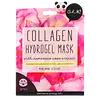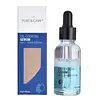What's inside
What's inside
 Key Ingredients
Key Ingredients

 Benefits
Benefits

 Concerns
Concerns

 Ingredients Side-by-side
Ingredients Side-by-side

Water
Skin ConditioningDipropylene Glycol
HumectantGlycerin
HumectantHydrolyzed Collagen
EmollientPalmitoyl Tripeptide-5
Skin ConditioningRosa Damascena Extract
MaskingCeratonia Siliqua Gum
EmollientChondrus Crispus Powder
AbrasiveChondrus Crispus Extract
Skin ConditioningPanthenol
Skin ConditioningCentella Asiatica Extract
CleansingPaeonia Suffruticosa Root Extract
Skin ProtectingChamomilla Recutita Flower Extract
MaskingBetaine
HumectantCellulose Gum
Emulsion StabilisingButylene Glycol
Humectant1,2-Hexanediol
Skin ConditioningPotassium Chloride
Algin
MaskingGlyceryl Caprylate
EmollientSucrose
HumectantSynthetic Fluorphlogopite
Sodium Polyacrylate
AbsorbentPolysorbate 20
EmulsifyingHydrogenated Polydecene
EmollientCalcium Aluminum Borosilicate
CI 77891
Cosmetic ColorantMica
Cosmetic ColorantDextrin
AbsorbentPantolactone
HumectantTrideceth-6
EmulsifyingSilica
AbrasiveTin Oxide
AbrasiveEthylhexylglycerin
Skin ConditioningCI 77491
Cosmetic ColorantDisodium EDTA
Parfum
MaskingWater, Dipropylene Glycol, Glycerin, Hydrolyzed Collagen, Palmitoyl Tripeptide-5, Rosa Damascena Extract, Ceratonia Siliqua Gum, Chondrus Crispus Powder, Chondrus Crispus Extract, Panthenol, Centella Asiatica Extract, Paeonia Suffruticosa Root Extract, Chamomilla Recutita Flower Extract, Betaine, Cellulose Gum, Butylene Glycol, 1,2-Hexanediol, Potassium Chloride, Algin, Glyceryl Caprylate, Sucrose, Synthetic Fluorphlogopite, Sodium Polyacrylate, Polysorbate 20, Hydrogenated Polydecene, Calcium Aluminum Borosilicate, CI 77891, Mica, Dextrin, Pantolactone, Trideceth-6, Silica, Tin Oxide, Ethylhexylglycerin, CI 77491, Disodium EDTA, Parfum
Water
Skin ConditioningCaprylic/Capric Triglyceride
MaskingHelianthus Annuus Seed Oil
EmollientGlycerin
HumectantSimmondsia Chinensis Seed Oil
EmollientButyrospermum Parkii Oil
EmollientPropylene Glycol
HumectantSqualane
EmollientButylene Glycol
HumectantPanthenol
Skin ConditioningTocopheryl Acetate
AntioxidantSodium Hyaluronate
HumectantSaccharide Isomerate
Humectant3-O-Ethyl Ascorbic Acid
Skin ConditioningXylitylglucoside
HumectantAnhydroxylitol
HumectantHexylene Glycol
EmulsifyingPhenoxyethanol
PreservativeOlea Europaea Oil Unsaponifiables
Skin ConditioningXylitol
HumectantRubus Chamaemorus Seed Extract
Skin ConditioningPolygonum Cuspidatum Root Extract
AntioxidantCentella Asiatica Extract
CleansingHydroxyethylcellulose
Emulsion StabilisingCollagen
MoisturisingHyaluronic Acid
HumectantOligopeptide-1
Skin ConditioningCamellia Sinensis Leaf Extract
AntimicrobialChamomilla Recutita Flower Extract
MaskingGlycyrrhiza Glabra Root Extract
BleachingRosmarinus Officinalis Leaf Extract
AntimicrobialScutellaria Baicalensis Root Extract
AstringentCI 42090
Cosmetic ColorantCitric Acid
BufferingSodium Citrate
BufferingOligopeptide-2
Skin ConditioningSodium Hydroxide
BufferingOligopeptide-5
Skin ConditioningEthylhexylglycerin
Skin ConditioningCellulose Gum
Emulsion StabilisingWater, Caprylic/Capric Triglyceride, Helianthus Annuus Seed Oil, Glycerin, Simmondsia Chinensis Seed Oil, Butyrospermum Parkii Oil, Propylene Glycol, Squalane, Butylene Glycol, Panthenol, Tocopheryl Acetate, Sodium Hyaluronate, Saccharide Isomerate, 3-O-Ethyl Ascorbic Acid, Xylitylglucoside, Anhydroxylitol, Hexylene Glycol, Phenoxyethanol, Olea Europaea Oil Unsaponifiables, Xylitol, Rubus Chamaemorus Seed Extract, Polygonum Cuspidatum Root Extract, Centella Asiatica Extract, Hydroxyethylcellulose, Collagen, Hyaluronic Acid, Oligopeptide-1, Camellia Sinensis Leaf Extract, Chamomilla Recutita Flower Extract, Glycyrrhiza Glabra Root Extract, Rosmarinus Officinalis Leaf Extract, Scutellaria Baicalensis Root Extract, CI 42090, Citric Acid, Sodium Citrate, Oligopeptide-2, Sodium Hydroxide, Oligopeptide-5, Ethylhexylglycerin, Cellulose Gum
Ingredients Explained
These ingredients are found in both products.
Ingredients higher up in an ingredient list are typically present in a larger amount.
Butylene Glycol (or BG) is used within cosmetic products for a few different reasons:
Overall, Butylene Glycol is a safe and well-rounded ingredient that works well with other ingredients.
Though this ingredient works well with most skin types, some people with sensitive skin may experience a reaction such as allergic rashes, closed comedones, or itchiness.
Learn more about Butylene GlycolCellulose Gum is a water-soluble polymer that comes from cellulose. It is used to change the texture of a product and to help stabilize emulsions.
As an emulsifier, cellulose gum specifically thicken the texture of water-based products.
This ingredient is considered hypoallergenic and non-toxic. Cellulose Gum can be found in cosmetics, food, and other household goods such as paper products.
Learn more about Cellulose GumCentella Asiatica Extract (Centella) is derived from an herb native to Southeast Asia. It is famous for its anti-inflammatory and soothing properties.
Centella is rich in antioxidants and amino acids, such as Madecassic Acid and Asiaticoside.
Studies show the compounds in centella help with:
The combination of all these properties makes centella effective at soothing, hydrating, and protecting the skin.
Other great components of centella include Vitamin A, vitamin C, several B vitamins, and Asiatic Acid.
Fun fact: Centella has been used as a medicine and in food for many centuries. As a medicine, it is used to treat burns, scratches, and wounds.
Learn more about Centella Asiatica ExtractChamomilla Recutita Flower Extract comes from the Chamomile flower.
Chamomile is rich in antioxidants and has anti-inflammatory properties. Several compounds found in chamomile help with soothing, such as bisbolol.
Antioxidant components in chamomile make it an effective ingredient to help slow the signs of aging. Antioxidants help fight free-radical molecules, or molecules that may damage your skin.
Essential oils from chamomile have been found to improve wound healing due to its antimicrobial properties.
Ancient Greeks and Egyptians used Chamomile to treat skin redness and dryness. Chamomile has also been used to help treat stomach issues.
Learn more about Chamomilla Recutita Flower ExtractEthylhexylglycerin (we can't pronounce this either) is commonly used as a preservative and skin softener. It is derived from glyceryl.
You might see Ethylhexylglycerin often paired with other preservatives such as phenoxyethanol. Ethylhexylglycerin has been found to increase the effectiveness of these other preservatives.
Glycerin is already naturally found in your skin. It helps moisturize and protect your skin.
A study from 2016 found glycerin to be more effective as a humectant than AHAs and hyaluronic acid.
As a humectant, it helps the skin stay hydrated by pulling moisture to your skin. The low molecular weight of glycerin allows it to pull moisture into the deeper layers of your skin.
Hydrated skin improves your skin barrier; Your skin barrier helps protect against irritants and bacteria.
Glycerin has also been found to have antimicrobial and antiviral properties. Due to these properties, glycerin is often used in wound and burn treatments.
In cosmetics, glycerin is usually derived from plants such as soybean or palm. However, it can also be sourced from animals, such as tallow or animal fat.
This ingredient is organic, colorless, odorless, and non-toxic.
Glycerin is the name for this ingredient in American English. British English uses Glycerol/Glycerine.
Learn more about GlycerinPanthenol is a common ingredient that helps hydrate and soothe the skin. It is found naturally in our skin and hair.
There are two forms of panthenol: D and L.
D-panthenol is also known as dexpanthenol. Most cosmetics use dexpanthenol or a mixture of D and L-panthenol.
Panthenol is famous due to its ability to go deeper into the skin's layers. Using this ingredient has numerous pros (and no cons):
Like hyaluronic acid, panthenol is a humectant. Humectants are able to bind and hold large amounts of water to keep skin hydrated.
This ingredient works well for wound healing. It works by increasing tissue in the wound and helps close open wounds.
Once oxidized, panthenol converts to pantothenic acid. Panthothenic acid is found in all living cells.
This ingredient is also referred to as pro-vitamin B5.
Learn more about PanthenolWater. It's the most common cosmetic ingredient of all. You'll usually see it at the top of ingredient lists, meaning that it makes up the largest part of the product.
So why is it so popular? Water most often acts as a solvent - this means that it helps dissolve other ingredients into the formulation.
You'll also recognize water as that liquid we all need to stay alive. If you see this, drink a glass of water. Stay hydrated!
Learn more about Water